Are you tired of navigating multiple folders and reaching for the file you want to use? Here is a small freeway tool to help you manage your important folders and work. We often need particular files and folders more frequently than the rest. Instead of creating multiple shortcut paths on your desktop, you can download this small utility tool for Windows PC and be organized. Here is a small guide on installing the Quick Access Popup tool and using it. As the makers of this tool introduce it, you can speed up your work with this multi-purpose launcher and folder switcher!
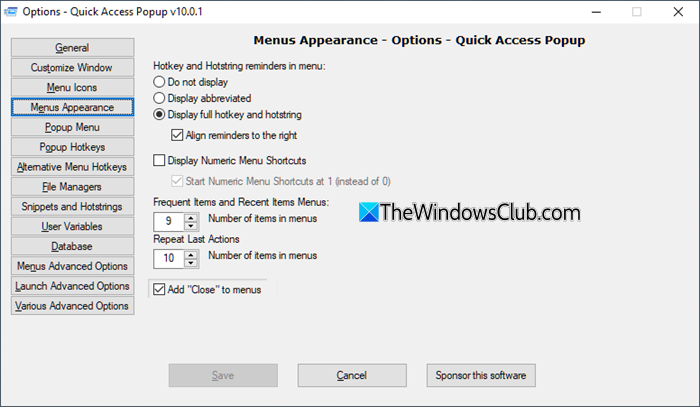
Quick Access Popup Tool for Windows PC
To use QAP, you need to have Windows 11/10. Downloading and installing the Quick Access Popup tool is easy as the setup file is only 1 MB large. It gets downloaded within seconds, and installation is relatively straightforward. The website of QAP has all sorts of support you will ever require while using this folder popup tool. FAQs, installation guides, and even how-to videos are available on this website.
Once the Quick Access Popup tool is installed, you can see its icon in the tray at the bottom. You can launch Quick Access Popup by clicking on its icon or typing Windows+W. It is the shortcut for the QAP freeway tool for Windows.
How to use and features of Quick Access Popup to access folders
Using the QAP tool is also equally easy. When clicked on the icon, the following menu opens up.
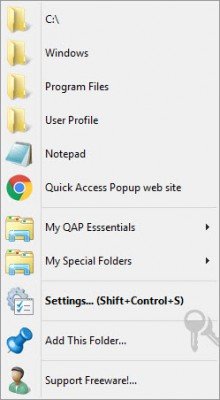
It will initially show you the startup menu.
My QAP Essentials
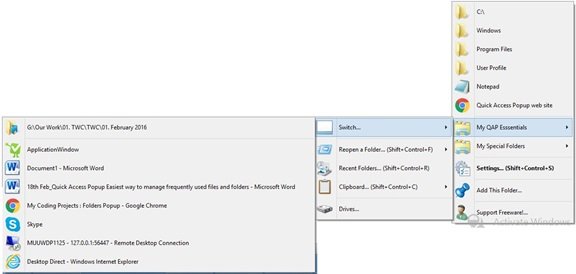
When you install QAP, a configurable menu, My QAP Essentials, is created. But you can customize this menu: add features, move them to other menus or remove them, in addition to selecting shortcuts or icons. It is pretty similar to ‘Recent Places’ in Windows File Explorer. You can see all your recent and open tabs, and you can switch amongst them. You can see it in the ‘Reopen a Folder’ if you have recently closed a folder.
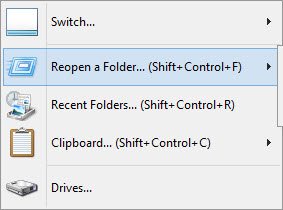
If you click on Recent Folders, you can see all recently visited folders. The Drives tab allows you to access all your Drives. So, in short, you can use the Quick Access Popup to access all the files and folders present on your PC.
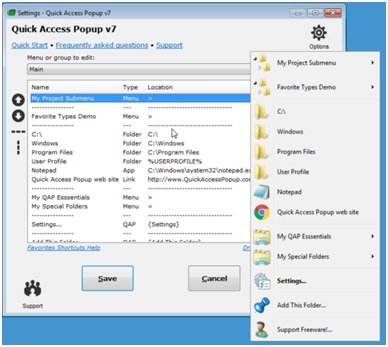
Various Types of Favorites
The Quick Access Popup has a variety of Favorites. You can link your favorite folders, documents, applications, special folders, and links with QAP. In addition to this, you can also connect FTP with this tool. You can open FTP sites in Explorer by automatically logging in with the username and password inserted in the site address. You can embed features like Reuse an Open Folder, Add This Folder, etc., in any submenu and assign them the shortcuts and icons of your choice. If you wish to group your favorites, QAP lets you create a group as well.
If you want to add or edit favorites, QAP offers four tabs to do so.
- Basic Settings: You can create a favorite menu name and assign the favorite’s path in this tab.
- Menu Options: Here, you can select an icon, shortcut, or favorite’s position in the menu. Using this tab, you can set Windows folders icons to the images chosen in QAP.
- Window Options: In this tab, you can manage the window’s position when opening a folder in a new window, available for Folders, Special folders, and FTP sites, with a configurable delay when moving/resizing the window.
- Advanced Settings: You can configure various advanced settings here depending on your favorite types.
Hotkeys for favorites and sub-menus
Using Quick Access Popup, you can assign a shortcut for each of your favorites (folder, file, etc.). It lets your folders, documents, applications, web, or FTP sites be launched with a hotkey. Even submenus can be opened with their hotkey. You can set a favorite’s hotkey in the Menu Options tab in the Add/Edit Favorite dialog box.
Other features of Quick Access Popup
Apart from the above main features, the QAP tool has several useful features. These are as follows:
- Navigation in the Settings window
- Creating a favorite by copying an existing one
- Popup menu Hotkeys
- Alternative menu
- Exclusion lists (To exclude particular QAP mouse triggers)
- File managers support
If you want to try Quick Access Popup, please download the .exe file of this freeware. A portable version is also available there.
How do I delete my recent files and frequent folders in Windows?
You can do that using the Start menu customization. Open Windows Settings and go to Personalization > Start and toggle off the option that says—Show recently opened items in Start, Jump List, and File Explorer. It will ensure nobody can see all the recently accessed files and folders.
Leave a Reply